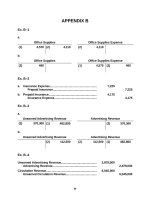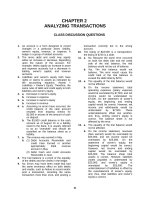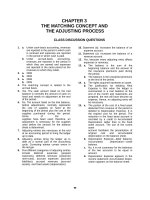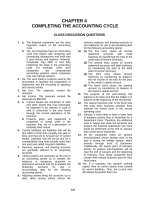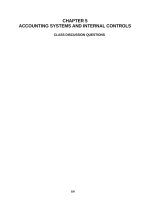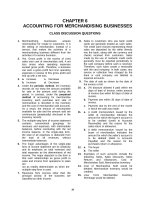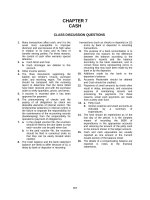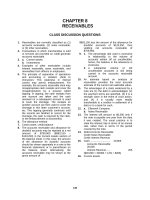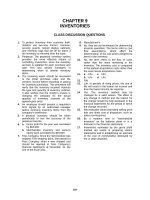Solution manual accounting 21e by warreni ch 09
Bạn đang xem bản rút gọn của tài liệu. Xem và tải ngay bản đầy đủ của tài liệu tại đây (194.66 KB, 36 trang )
CHAPTER 9
INVENTORIES
CLASS DISCUSSION QUESTIONS
1. To protect inventory from customer theft,
retailers use two-way mirrors, cameras,
security guards, locked display cabinets,
and inventory tags that set off an alarm if
the inventory is removed from the store.
2. Perpetual. The perpetual inventory system
provides the more effective means of
controlling inventories, since the inventory
account is updated for each purchase and
sale. This also assists managers in
determining when to reorder inventory
items.
3. The receiving report should be reconciled
to the initial purchase order and the
vendor's invoice before recording or paying
for inventory purchases. This procedure will
verify that the inventory received matches
the type and quantity of inventory ordered.
It also verifies that the vendor's invoice is
charging the company for the actual
quantity of inventory received at the
agreed-upon price.
4. An employee should present a requisition
form signed by an authorized manager
before receiving inventory items from the
company's warehouse.
5. A physical inventory should be taken
periodically to test the accuracy of the
perpetual records.
6. a. Gross profit for the year was overstated
by $18,500.
b. Merchandise inventory and owner’s
equity were overstated by $18,500.
7. Fess Company. Since the merchandise was
shipped FOB shipping point, title passed to
Fess Company when it was shipped and
should be reported in Fess Company's
financial statements at December 31, the
end of the fiscal year.
8. Manufacturer's
9. No, they are not techniques for determining
physical quantities. The terms refer to cost
flow assumptions, which affect the
determination of the cost prices assigned to
items in the inventory.
10. No, the term refers to the flow of costs
rather than the items remaining in the
inventory. The inventory cost is composed
of the earliest acquisitions costs rather than
the most recent acquisitions costs.
11. a. Fifo
c. Fifo
b. Lifo
d. Lifo
12. Fifo
13. Lifo. In periods of rising prices, the use of
lifo will result in the lowest net income and
thus the lowest income tax expense.
14. Yes. The inventory method may be
changed for a valid reason. The effect of
any change in method and the reason for
the change should be fully disclosed in the
financial statements for the period in which
the change occurred.
15. Net realizable value (estimated selling price
less any direct cost of disposition, such as
sales commissions).
16. By a notation next to "merchandise
inventory" on the balance sheet or in a
footnote to the financial statements.
17. Inventories estimated by the gross profit
method are useful in preparing interim
statements and in establishing an estimate
of the cost of merchandise destroyed by
fire or other disasters.
187
EXERCISES
Ex. 9–1
Switching to a perpetual inventory system will strengthen Onsite Hardware’s
internal controls over inventory, since the store managers will be able to keep
track of how much of each item is on hand. This should minimize shortages of
good-selling items and excess inventories of poor-selling items.
On the other hand, switching to a perpetual inventory system will not eliminate
the need to take a physical inventory count. A physical inventory must be taken to
verify the accuracy of the inventory records in a perpetual inventory system. In
addition, a physical inventory count is needed to detect shortages of inventory
due to damage or theft.
Ex. 9–2
a.
Inappropriate. Good internal controls include a receiving report, prepared
after all inventory items received have been counted and inspected. Inventory
purchased should only be recorded and paid for after reconciling the
receiving report, the initial purchase order, and the vendor’s invoice.
b. Appropriate. The inventory tags will protect the inventory from customer
theft.
c. Inappropriate. The internal control procedure of using security measures to
protect the inventory is violated if the stockroom is not locked.
Ex. 9–3
Include in inventory: c, e, g, i
Exclude from inventory: a, b, d, f, h
Ex. 9–4
a.
Balance Sheet
Merchandise inventory
$1,950 understated
Current assets
$1,950 understated
Total assets
$1,950 understated
Owner’s equity
$1,950 understated
b.
Cost of merchandise sold
Gross profit
Income Statement
$1,950 overstated
$1,950 understated
Net income
$1,950 understated
Ex. 9–5
a.
Balance Sheet
Merchandise inventory
$4,150 overstated
Current assets
$4,150 overstated
Total assets
$4,150 overstated
Owner’s equity
$4,150 overstated
b.
Cost of merchandise sold
Gross profit
Net income
Income Statement
$4,150 understated
$4,150 overstated
$4,150 overstated
Ex. 9–6
When an error is discovered affecting the prior period, it should be corrected. In
this case, the merchandise inventory account should be debited and the owner’s
capital account credited for $12,800.
Failure to correct the error for 2005 and purposely misstating the inventory and
the cost of merchandise sold in 2006 would cause the balance sheets and the
income statements for the two years to not be comparable.
Ex. 9–7
Date
April 1
5
11
Purchases
Unit
Quantity
Cost
15
53
Total
Cost
7
54
26
50
1,300
9
3
4
50
53
53
450
159
212
795
21
28
30
Portable CD Players
Cost of Merchandise Sold
Unit
Total
Quantity
Cost
Cost
378
Total cost of merchandise sold......................................................
Inventory, April 30: $802 ($424 + $378)
2,121
Quantity
Inventory
Unit
Cost
Total
Cost
35
9
9
15
12
50
50
50
53
53
1,750
450
450
795
636
8
8
7
53
53
54
424
424
378
Ex. 9–8
Date
April 1
5
11
Purchases
Unit
Quantity
Cost
Total
Cost
Portable CD Players
Cost of Merchandise Sold
Unit
Total
Quantity
Cost
Cost
26
50
1,300
21
12
53
636
28
3
1
53
50
159
50
30
15
7
53
54
795
378
Total cost of merchandise sold......................................................
Inventory, April 30: $778 ($400 + $378)
2,145
Quantity
Inventory
Unit
Cost
Total
Cost
35
9
9
15
9
3
8
50
50
50
53
50
53
50
1,750
450
450
795
450
159
400
8
7
50
54
400
378
Ex. 9–9
Date
Mar.
1
5
Purchases
Unit
Quantity
Cost
20
94
Total
Cost
Cell Phones
Cost of Merchandise Sold
Unit
Total
Quantity
Cost
Cost
1,880
9
18
94
1,692
13
2
18
94
90
188
1,620
21
15
95
1,425
31
8
95
Total cost of merchandise sold......................................................
Inventory, March 31: $1,295 ($630 + $665)
760
4,260
Quantity
Inventory
Unit
Cost
Total
Cost
25
25
20
25
2
7
90
90
94
90
94
90
2,250
2,250
1,880
2,250
188
630
7
15
7
7
90
95
90
95
630
1,425
630
665
Ex. 9–10
Date
Mar.
1
5
Purchases
Unit
Quantity
Cost
20
94
Total
Cost
Cell Phones
Cost of Merchandise Sold
Unit
Total
Quantity
Cost
Cost
1,880
9
18
90
1,620
13
7
13
90
94
630
1,222
7
1
94
95
658
95
21
15
95
31
1,425
Total cost of merchandise sold......................................................
Inventory, March 31: $1,330
4,225
Quantity
Inventory
Unit
Cost
Total
Cost
25
25
20
7
20
90
90
94
90
94
2,250
2,250
1,880
630
1,880
7
7
15
94
94
95
658
658
1,425
14
95
1,330
Ex. 9–11
a. $700 ($50 × 14 units)
b. $663 [($45 × 5 units) + ($47 × 4 units) + ($50 × 5 units)]
Ex. 9–12
a. $360 (8 units at $33 plus 3 units at $32)
b. $318 (6 units at $28 plus 5 units at $30)
c. $341 (11 units at $31; $1,240 ÷ 40 units = $31)
Cost of merchandise available for sale:
6 units at $28..........................................................
12 units at $30..........................................................
14 units at $32..........................................................
8 units at $33..........................................................
40 units (at average cost of $31).............................
$ 168
360
448
264
$1,240
Ex. 9–13
Cost
Inventory Method
a. Fifo........................
b. Lifo........................
c. Average cost........
Merchandise
Inventory
$5,016
4,320
4,680
Merchandise
Sold
$14,484
15,180
14,820
Cost of merchandise available for sale:
42 units at $120........................................................
58 units at $130........................................................
20 units at $136........................................................
30 units at $140........................................................
150 units (at average cost of $130)...........................
a.
First-in, first-out:
Merchandise inventory:
30 units at $140........................................................
6 units at $136........................................................
36 units.....................................................................
Merchandise sold:
$19,500 – $5,016.......................................................
b. Last-in, first-out:
Merchandise inventory:
36 units at $120........................................................
Merchandise sold:
$19,500 – $4,320.......................................................
c. Average cost:
Merchandise inventory:
36 units at $130 ($19,500 ÷ 150 units).....................
Merchandise sold:
$19,500 – $4,680.......................................................
$ 5,040
7,540
2,720
4,200
$19,500
$4,200
816
$5,016
$14,484
$4,320
$15,180
$4,680
$14,820
Ex. 9–14
1.
a.
b.
c.
d.
LIFO inventory
LIFO cost of goods sold
LIFO net income
LIFO income tax
< (less than)
> (greater than)
< (less than)
< (less than)
FIFO inventory
FIFO cost of goods sold
FIFO net income
FIFO income tax
2. Under the lifo conformity rule a company selecting lifo for tax purposes must
also use lifo for financial reporting purposes. Thus, in periods of rising prices
the reported net income would be lower than would be the case under fifo.
However, the lower reported income would also be shown on the
corporation’s tax return; thus, there is a tax advantage from using lifo. Firms
electing to use lifo believe the tax advantage from using lifo outweighs any
negative impact from reporting a lower earnings number to shareholders. Lifo
is supported because the tax impact is a real cash flow benefit, while a lower
lifo earnings number (compared to fifo) is merely the result of a reporting
assumption.
Ex. 9–15
Commodity
M76......................
T53......................
A19......................
J81.......................
K10......................
Total...............
Inventory
Quantity
8
20
10
15
25
Unit
Cost
Price
$150
75
275
50
101
Unit
Market
Price
$160
70
260
40
105
Total
Cost
Market
Lower
of C or M
$1,200
1,500
2,750
750
2,525
$8,725
$1,280
1,400
2,600
600
2,625
$8,505
$1,200
1,400
2,600
600
2,525
$8,325
Ex. 9–16
The merchandise inventory would appear in the Current Assets section, as
follows:
Merchandise inventory—at lower of cost, fifo, or market............
$8,325
Alternatively, the details of the method of determining cost and the method of
valuation could be presented in a note.
Ex. 9–17
$495,450 ($825,750 × 60%)
Ex. 9–18
Merchandise inventory, June 1..................................
Purchases in June (net)..............................................
Merchandise available for sale...................................
Cost
$160,000
680,000
$840,000
Retail
$ 180,000
1,020,000
$1,200,000
Ratio of cost to retail price:
$ 840,000
70%
$1,200,000
Sales for June (net).....................................................
Merchandise inventory, June 30, at retail price.........
Merchandise inventory, June 30,
at estimated cost ($325,000 × 70%)......................
875,000
$ 325,000
$ 227,500
Ex. 9–19
a.
Merchandise inventory, Jan. 1....................................
Purchases (net), Jan. 1–May 17..................................
Merchandise available for sale...................................
Sales (net), Jan. 1–May 17..........................................
Less estimated gross profit ($1,250,000 × 35%).......
Estimated cost of merchandise sold.........................
Estimated merchandise inventory, May 17................
$180,000
750,000
$930,000
$1,250,000
437,500
812,500
$117,500
b. The gross profit method is useful for estimating inventories for monthly or
quarterly financial statements. It is also useful in estimating the cost of
merchandise destroyed by fire or other disasters.
Ex. 9–20
a.
Apple: 147.8 {$4,139,000,000 ÷ [($45,000,000 + $11,000,000) ÷ 2]}
American Greetings: 3.1 {$881,771,000 ÷ [($278,807,000 + $290,804,000) ÷ 2]}
b. Lower. Although American Greetings’ business is seasonal in nature, with
most of its revenue generated during the major holidays, much of its
nonholiday inventory may turn over very slowly. Apple, on the other hand,
turns its inventory over very fast because it maintains a low inventory, which
allows it to respond quickly to customer needs. Additionally, Apple’s
computer products can quickly become obsolete, so it cannot risk building
large inventories.
Ex. 9–21
a.
Number of days’ sales in inventory =
Albertson’s,
Kroger,
$2,973
= 43 days
$25,242/36 5
$4,175
= 40 days
$37,810/36 5
Safeway,
$2,558
= 42 days
$22,303/36 5
Inventory turnover =
Albertson’s,
Kroger,
Inventory, end of period
Cost of goods sold/365
Cost of goods sold
Average inventory
$25,242
= 8.2
($2,973 $3,196)/2
$37,810
= 9.1
($4,175 $4,178)/2
Safeway,
$22,303
= 8.9
($2,558 $2,437)/2
b. The number of days’ sale in inventory and inventory turnover ratios are
consistent. Albertson’s has slightly more inventory than does Safeway.
Kroger has relatively less inventory (2–3 days) than does Albertson’s and
Safeway.
Ex. 9–21
Concluded
c. If Albertson’s matched Kroger’s days’ sales in inventory, then its hypothetical
ending inventory would be determined as follows,
Number of days’ sales in inventory =
40 days =
Inventory, end of period
Cost of goods sold/365
X
$25,242/36 5
X = 40 ($25,242/365)
X = $2,766
Thus, the additional cash flow that would have been generated is the
difference between the actual ending inventory and the hypothetical ending
inventory, as follows:
Actual ending inventory...........................
Hypothetical ending inventory................
Positive cash flow potential.....................
$ 2,973 million
2,766
$ 207 million
That is, a lower ending inventory amount would have required less cash than
actually was required.
PROBLEMS
Prob. 9–1A
1.
Purchases
Unit
Quantity
Cost
Date
Aug.
Sept.
1
8
18
2,250
Total
Cost
Drift Boats
Cost of Merchandise Sold
Unit
Total
Quantity
Cost
Cost
40,500
11
12
2,200
26,400
22
10
1
2,200
2,250
22,000
2,250
10
10
2,250
22,500
21
5
2,250
11,250
3
30
16
20
2,300
2,350
36,800
47,000
Quantity
Inventory
Unit
Cost
Total
Cost
22
22
18
10
18
2,200
2,200
2,250
2,200
2,250
48,400
48,400
40,500
22,000
40,500
17
17
16
7
16
2
16
2
16
20
2,250
2,250
2,300
2,250
2,300
2,250
2,300
2,250
2,300
2,350
38,250
38,250
36,800
15,750
36,800
4,500
36,800
4,500
36,800
47,000
Continued
Prob. 9–1A
Date
Oct.
Concluded
Purchases
Unit
Quantity
Cost
Total
Cost
5
13
21
30
2,400
Drift Boats
Cost of Merchandise Sold
Unit
Total
Quantity
Cost
Cost
2
16
2
12
2,250
2,300
2,350
2,350
4,500
36,800
4,700
28,200
6
9
2,350
2,400
14,100
21,600
72,000
28
Total cost of merchandise sold......................................
434,400
Cost of Merchandise Sold..............................................
Merchandise Inventory..............................................
194,300
$240,100 ($434,400 – $194,300)
4. $50,400
18
2,350
42,300
6
6
30
2,350
2,350
2,400
14,100
14,100
72,000
21
2,400
50,400
194,300
2. Accounts Receivable......................................................
Sales...........................................................................
3.
Quantity
Inventory
Unit
Cost
434,400
194,300
Total
Cost
Prob. 9–2A
1.
Date
Aug. 1
8
Purchases
Unit
Quantity
Cost
18
2,250
Total
Cost
Drift Boats
Cost of Merchandise Sold
Unit
Total
Quantity
Cost
Cost
40,500
11
12
2,250
27,000
22
6
5
2,250
2,200
13,500
11,000
Sept. 3
16
2,300
36,800
10
10
2,300
23,000
21
5
2,300
11,500
30
20
2,350
47,000
Quantity
Inventory
Unit
Cost
22
22
18
22
6
17
2,200
2,200
2,250
2,200
2,250
2,200
48,400
48,400
40,500
48,400
13,500
37,400
17
16
17
6
17
1
17
1
20
2,200
2,300
2,200
2,300
2,200
2,300
2,200
2,300
2,350
37,400
36,800
37,400
13,800
37,400
2,300
37,400
2,300
47,000
Total
Cost
Continued
Prob. 9–2A
Date
Oct.
Concluded
Purchases
Unit
Quantity
Cost
Total
Cost
Drift Boats
Cost of Merchandise Sold
Unit
Total
Quantity
Cost
Cost
5
20
2,350
47,000
13
1
11
2,300
2,200
2,300
24,200
21
30
2,400
28
72,000
15
2,400
Total cost of merchandise sold...........................................
2. Total sales........................................................................
Total cost of merchandise sold .....................................
Gross profit ....................................................................
3.
$49,200 ($13,200 + $36,000)
36,000
195,500
$434,400
195,500
$238,900
Quantity
Inventory
Unit
Cost
Total
Cost
17
1
6
2,200
2,300
2,200
37,400
2,300
13,200
6
30
6
15
2,200
2,400
2,200
2,400
13,200
72,000
13,200
36,000
Prob. 9–3A
1.
First-In, First-Out Method
Model
Quantity
Unit Cost
231T
4
$225
2
213
673W
2
535
2
530
193Q
6
542
1
549
144Z
6
225
5
222
160M
4
317
1
316
180X
2
232
971K
6
156
Total.................................................................
Total Cost
$
900
426
1,070
1,060
3,252
549
1,350
1,110
1,268
316
464
936
$ 12,701
2. Last-In, First-Out Method
Model
231T
Quantity
Unit Cost
3
$208
3
212
673W
2
520
2
527
193Q
6
520
1
531
144Z
9
213
2
215
160M
5
305
180X
2
222
971K
4
140
2
144
Total.................................................................
Total Cost
$
624
636
1,040
1,054
3,120
531
1,917
430
1,525
444
560
288
$ 12,169
Prob. 9–3A
3.
Concluded
Average Cost Method
Model
Quantity
Unit Cost
231T
6
$215*
673W
4
528
193Q
7
534
144Z
11
218
160M
5
311
180X
2
227
971K
6
148
Total.................................................................
Total Cost
$ 1,290
2,112
3,738
2,398
1,555
454
888
$ 12,435
* $215 = [(3 × $208) + (3 × $212) + (5 × $213) + (4 × $225)] ÷ (3 + 3 + 5 + 4)
4.
a.
During periods of rising prices, the lifo method will result in a lesser
amount of inventory, a greater amount of the cost of merchandise sold,
and a lesser amount of net income than the other two methods. For
Henning Appliances, the lifo method would be preferred for the current
year, since it would result in a lesser amount of income tax.
b.
During periods of declining prices, the fifo method will result in a lesser
amount of net income and would be preferred for income tax purposes.
Prob. 9–4A
Inventory Sheet
December 31, 2006
Description
A90
Inventory
Quantity
35
C18
16
D41
24
E34
125
F17
18
25
10
16
8
6
12
Unit
Cost
Price
$ 59
58
Unit
Market
Price
$ 57
Total
Cost
Market
Lower
of C or M
$ 1,475
580
$ 1,425
570
2,055
1,995
$ 1,995
3,008
188
200
3,008
3,200
145
142
140
2,320
1,136
2,240
1,120
3,456
3,360
3,360
3,125
25
26
3,125
3,250
550
540
550
3,300
6,480
3,300
6,600
9,780
9,900
9,780
G68
60
14
15
840
900
840
K41
5
400
390
2,000
1,950
1,950
Q79
375
6
6
2,250
2,250
2,250
R72
100
18
16
17
1,260
480
1,190
510
1,740
1,700
1,250
260
1,175
235
1,510
1,410
2,400
340
2,160
360
2,740
2,520
5,608
699
6,307
5,600
700
6,300
S60
W21
Z35
6
140
9
70
30
5
1
120
20
8
1
250
260
20
17
701
699
235
18
700
1,700
1,410
2,520
6,300
$38,238
Prob. 9–5A
1.
BOZEMAN CO.
Cost
Merchandise inventory, February 1.................................. $ 210,000
Net purchases....................................................................
1,135,500
Merchandise available for sale......................................... $ 1,345,500
Retail
$ 300,000
1,650,000
$ 1,950,000
Ratio of cost to retail price:
$1,345,500
69%
$1,950,000
Sales................................................................................... $ 1,800,000
Less sales returns and allowances..................................
40,000
Net sales.............................................................................
Merchandise inventory, February 28, at retail..................
Merchandise inventory, at estimated cost
($190,000 × 69%).........................................................
2.
1,760,000
$ 190,000
$
131,100
a.
GALLATIN CO.
Merchandise inventory, March 1................................
Net purchases.............................................................
Merchandise available for sale...................................
Sales............................................................................ $ 2,510,000
Less sales returns and allowances............................
110,000
Net sales...................................................................... $ 2,400,000
Less estimated gross profit ($2,400,000 × 36%).......
864,000
Estimated cost of merchandise sold.........................
Estimated merchandise inventory, April 30...............
$
250,000
1,385,000
$ 1,635,000
$
1,536,000
99,000
b.
Estimated merchandise inventory, April 30...............
Physical inventory count, April 30.............................
Estimated loss due to theft or damage,
March 1–April 30....................................................
$
99,000
88,125
$
10,875
Prob. 9–1B
1.
Date
Apr.
1
8
Purchases
Unit
Quantity
Cost
800
2.20
Total
Cost
1,760
20
May
30
8
10
500
2.30
750
2.40
30
400
2.60
2.10
2.20
2.20
2.20
420
330
990
110
150
200
200
2.20
2.30
2.30
330
460
460
100
250
2.30
2.40
230
600
500
2.40
1,200
1,800
13
23
200
150
450
50
1,150
27
31
June 5
Floor Mats
Cost of Merchandise Sold
Unit
Total
Quantity
Cost
Cost
1,040
Total cost of merchandise sold...........................................
5,130
Quantity
Inventory
Unit
Cost
Total
Cost
200
200
800
2.10
2.10
2.20
420
420
1,760
650
200
150
150
500
2.20
2.20
2.20
2.20
2.30
1,430
440
330
330
1,150
300
100
100
750
2.30
2.30
2.30
2.40
690
230
230
1,800
500
500
400
400
2.40
2.40
2.60
2.60
1,200
1,200
1,040
1,040
Prob. 9–1B
Concluded
2. Accounts Receivable.................................
Sales......................................................
10,025
Cost of Merchandise Sold.........................
Merchandise Inventory.........................
5,130
3.
$4,895 ($10,025 – $5,130)
4. $1,040
10,025
5,130
Prob. 9–2B
1.
Date
Apr.
May
1
8
Purchases
Unit
Quantity
Cost
800
2.20
Total
Cost
Floor Mats
Cost of Merchandise Sold
Unit
Total
Quantity
Cost
Cost
1,760
20
350
2.20
770
30
8
10
450
50
2.20
2.10
990
105
27
350
2.30
805
31
150
50
2.30
2.10
345
105
June 5
500
750
2.30
2.40
1,150
1,800
13
23
30
400
2.60
350
2.40
840
400
100
2.60
2.40
1,040
240
1,040
Total cost of merchandise sold...........................................
5,240
Quantity
Inventory
Unit
Cost
Total
Cost
200
200
800
200
450
200
150
150
500
150
150
100
2.10
2.10
2.20
2.10
2.20
2.10
2.10
2.10
2.30
2.10
2.30
2.10
420
420
1,760
420
990
420
315
315
1,150
315
345
210
100
750
100
400
100
400
400
100
300
2.10
2.40
2.10
2.40
2.10
2.40
2.60
2.10
2.40
210
1,800
210
960
210
960
1,040
210
720
Prob. 9–2B
Concluded
2. Total sales........................................................................
Total cost of merchandise sold......................................
Gross profit.....................................................................
3. $930 ($210 + $720)
$ 10,025
5,240
$ 4,785
